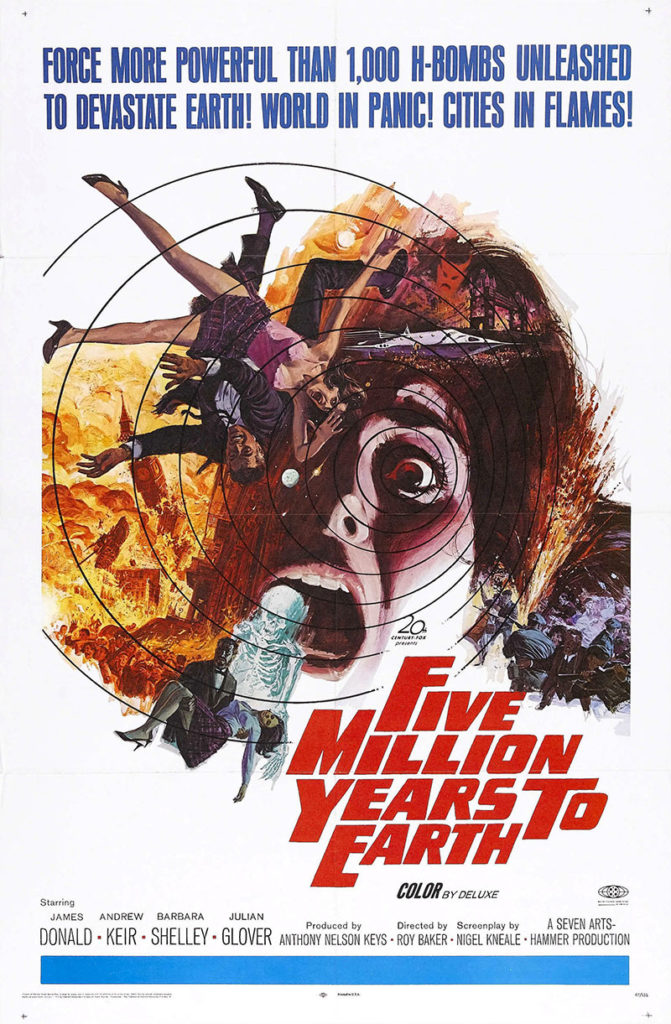It’s a new era for Quatermass. Because of Hammer’s success with its horror films, the third Quatermass film had an increased budget compared to the previous entries. Whereas The Quatermass Xperiment had to get by on a mere £42,000, Quatermass and the Pit had an astronomical £275,000 with which to work its magic. Gone is the inexpensive black and white film stock, replaced with color. It’s still an inexpensive stock, but COLOR.
Also gone is Brian Donlevy as Professor Bernard Quatermass. He had been cast in the previous films in an attempt to appeal to the American market, but that didn’t seem to be a concern with this film. Taking on the role, though not replacing Donlevy’s gruff, highly-motivated, door to door salesman of a rocket scientist (because one can’t simply replace Brian Donlevy) is Andrew Keir, last seen this month playing the abbot in Dracula: Prince of Darkness.
Keir is a much different Quatermass than Donlevy. For one, he’s much more low energy. But not lazy. In Donlevy’s portrayal, Quatermass never stopped moving, attacking scientific questions and emergencies alike at an epic pace. Quatermass was a man who got things done. Keir’s portrayal has the professor being much more professorial. He’s no longer the biggest man in the room. In fact, he’s no longer got top billing. It’s an adjustment viewers familiar with the previous films will have to get used to, but it doesn’t take long. Keir is just fine in the role.
Coming along in 1967, ten years after the previous film, Quatermass and the Pit (titled Five Million Years to Earth in the US) finds Quatermass in, well, a pit. A construction crew extending the fictional Hobbs End tube station unearths fossils of man’s evolutionary progenitors. A scientist, Doctor Roney (James Donald, who did get top billing), determines the fossils are at least five million years old. Further  excavations reveal a large object buried in the mud. This being London only a couple of decades after the war, the immediate thought is that an unexploded German bomb has been found. The army is called in.
excavations reveal a large object buried in the mud. This being London only a couple of decades after the war, the immediate thought is that an unexploded German bomb has been found. The army is called in.
Heading the bomb disposal group is Julian Glover as Colonel Breen. He’s the shithead of the film. All viewers know the type. There’s a good guy going up against a very bad thing, and the shithead, usually an authority figure, does all they can to stop the progress of the good guy, without being in league with the baddies themselves. Most films that have a shithead don’t need one (think Cary Elwes in Twister). There’s usually already enough plot to make the shithead superfluous, and that’s sort of the case here. But, it’s the shithead who brings Quatermass to the excavation site, so there was some purpose to having him.
Quatermass isn’t buying that the buried object is a bomb. He doesn’t jump to any conclusions, at first, but he is right that there isn’t much to indicate any danger. Further investigating reveals that the object is made of a super hard material that is impervious to all efforts to breach it. But it is not inert.
The area around the station was formerly known as Hob’s Lane. Hob, we are informed in a useful bit of exposition, is an old nickname for the devil. Apparently, Hob’s Lane has been a hotspot of paranormal activity dating back to antiquity. Quatermass surmises that the history of disturbances is related to the long-buried object. What follows is a battle of wills between Quatermass and Colonel Breen, each convinced they are right about the origins of the mysterious object.
Almost all the way to the end of this film, the plot could be described as ‘two men try to prove each other wrong,’ because, other than an isolated case here and there, there doesn’t seem to be any danger inherent in the object. That thankfully changes for the film’s climax. Being almost all setup, there are loads of missed opportunities for shenanigans to keep the audience engaged. For example, Nigel Kneale’s script (again adapting his own BBC television serial) opens the door for some spectral apparitions, but doesn’t deliver.
Almost the entire film is spent waiting for something to happen. It’s a testament to the skill of director Roy Ward Baker that he kept such a dialogue-heavy film full of tension. Really the only failing with the film is a laughable sequence showing alien locusts at war. I had more realistic battles with green plastic army men in my parents’ backyard when I was a kid. It almost threw me out of the film completely, but then I remembered that despite having six times the budget of the original, Quatermass and the Pit is still a Hammer flick. There’s only so much one can expect.
Quatermass and the Pit is not the kind of film for people who crave nonstop action. There’s always the promise of a much busier film, and it feels like budget is the only thing holding it back. That said, within ten minutes this film was at least ten times more interesting than the previous film this month, The Mummy’s Shroud. The story is original, Quatermass is an interesting chap, and there isn’t much that can be predicted beforehand. Of the three Quatermass films, this is the best, and is also near the top of the Hammer films I’ve watched for this month.
